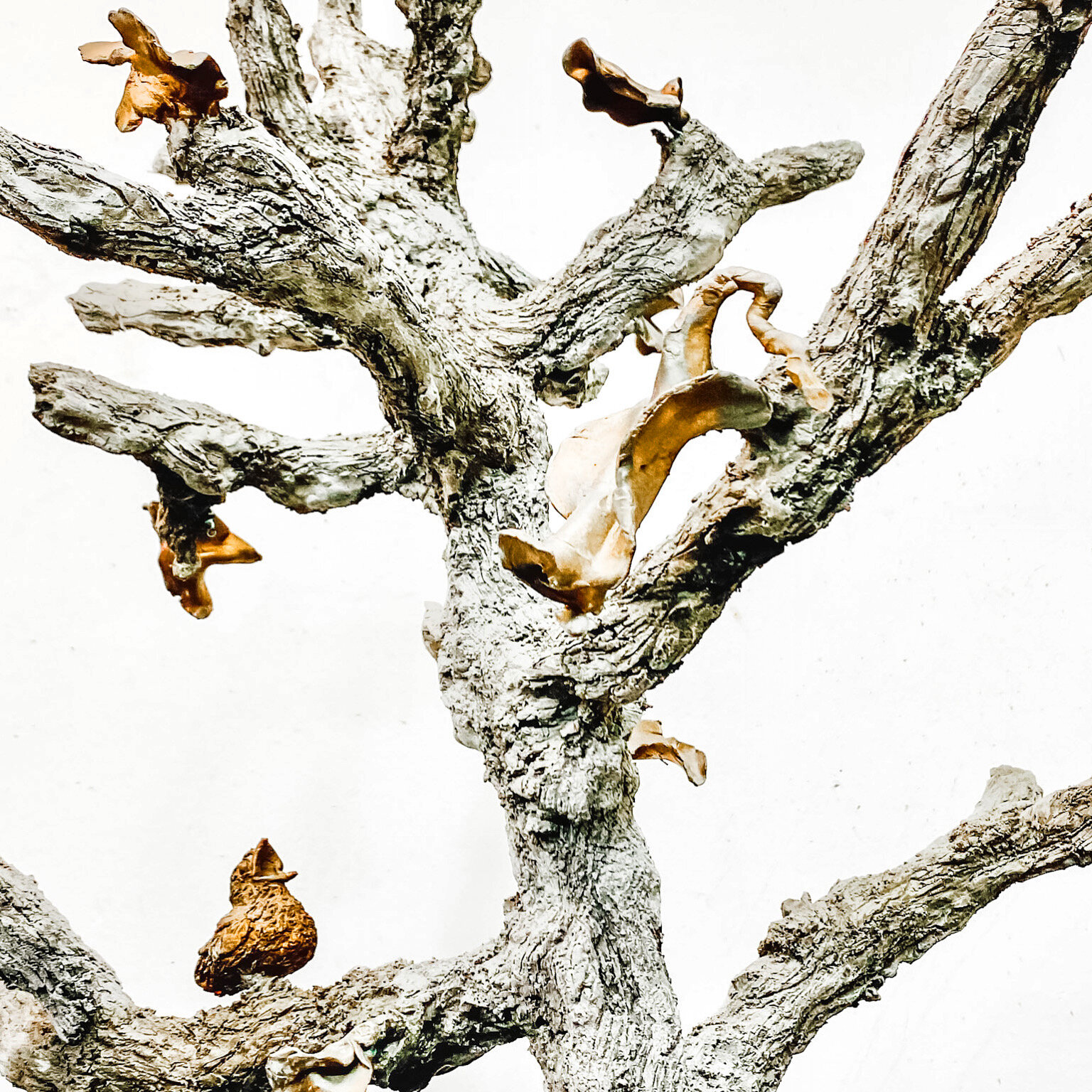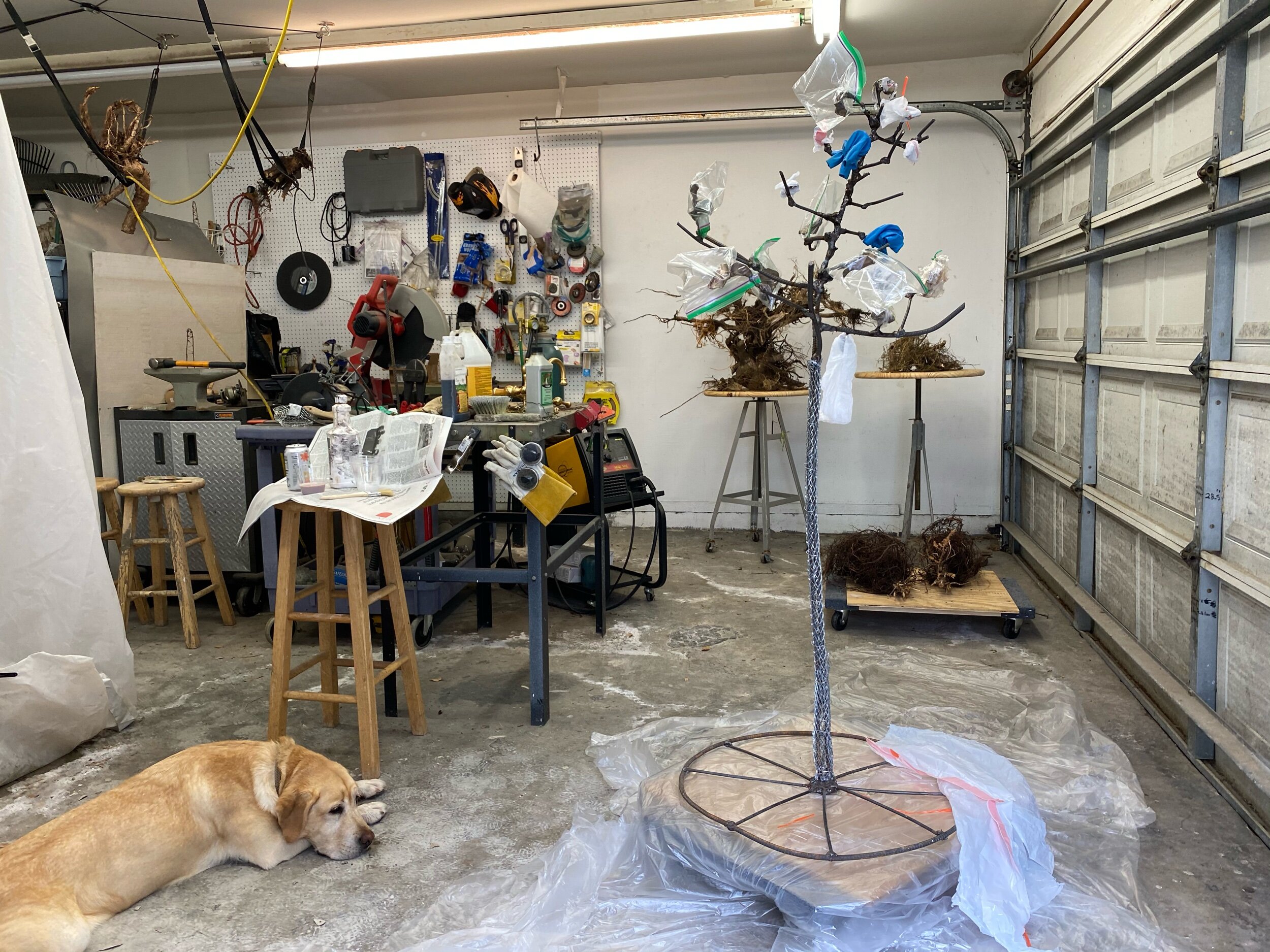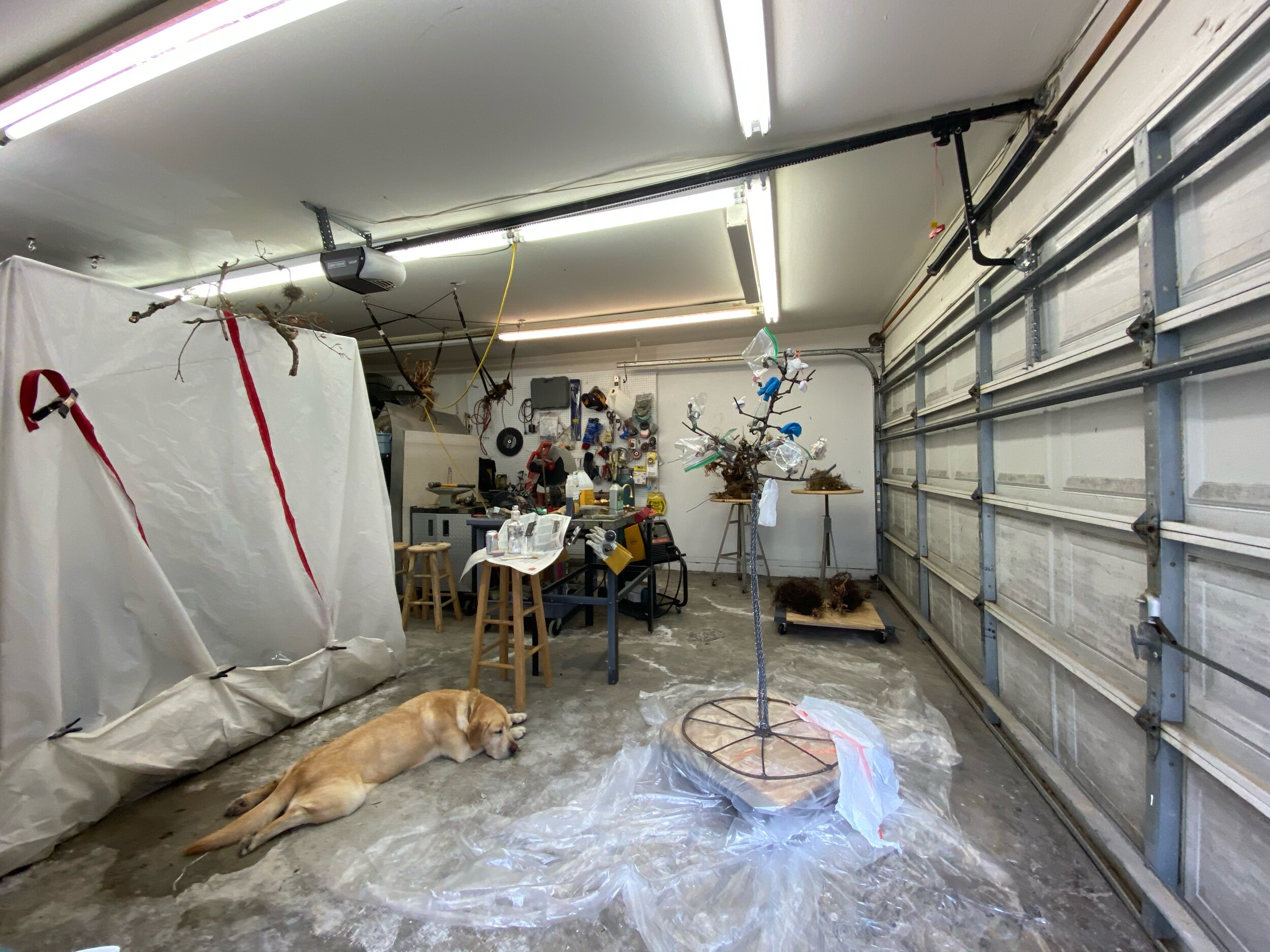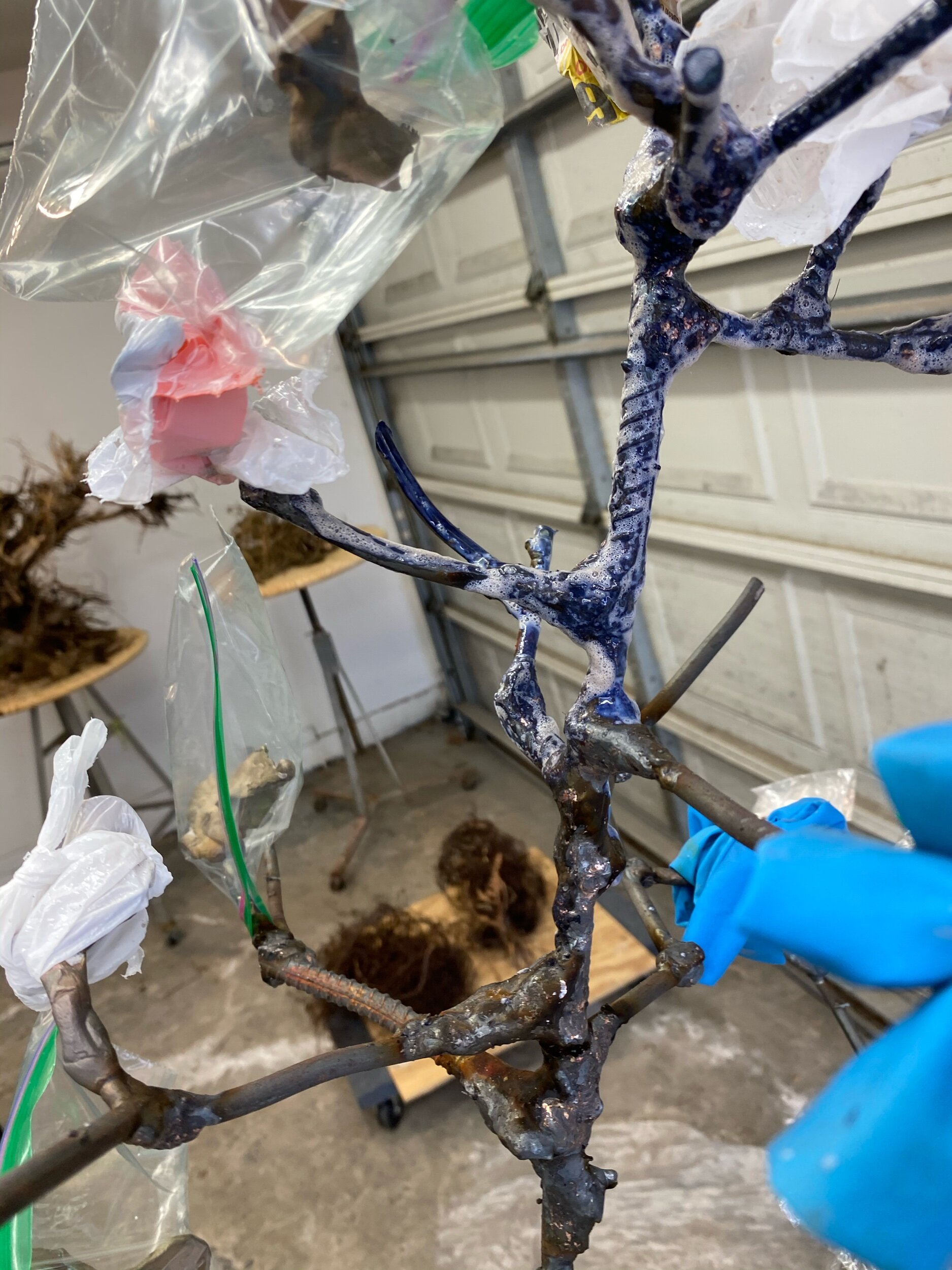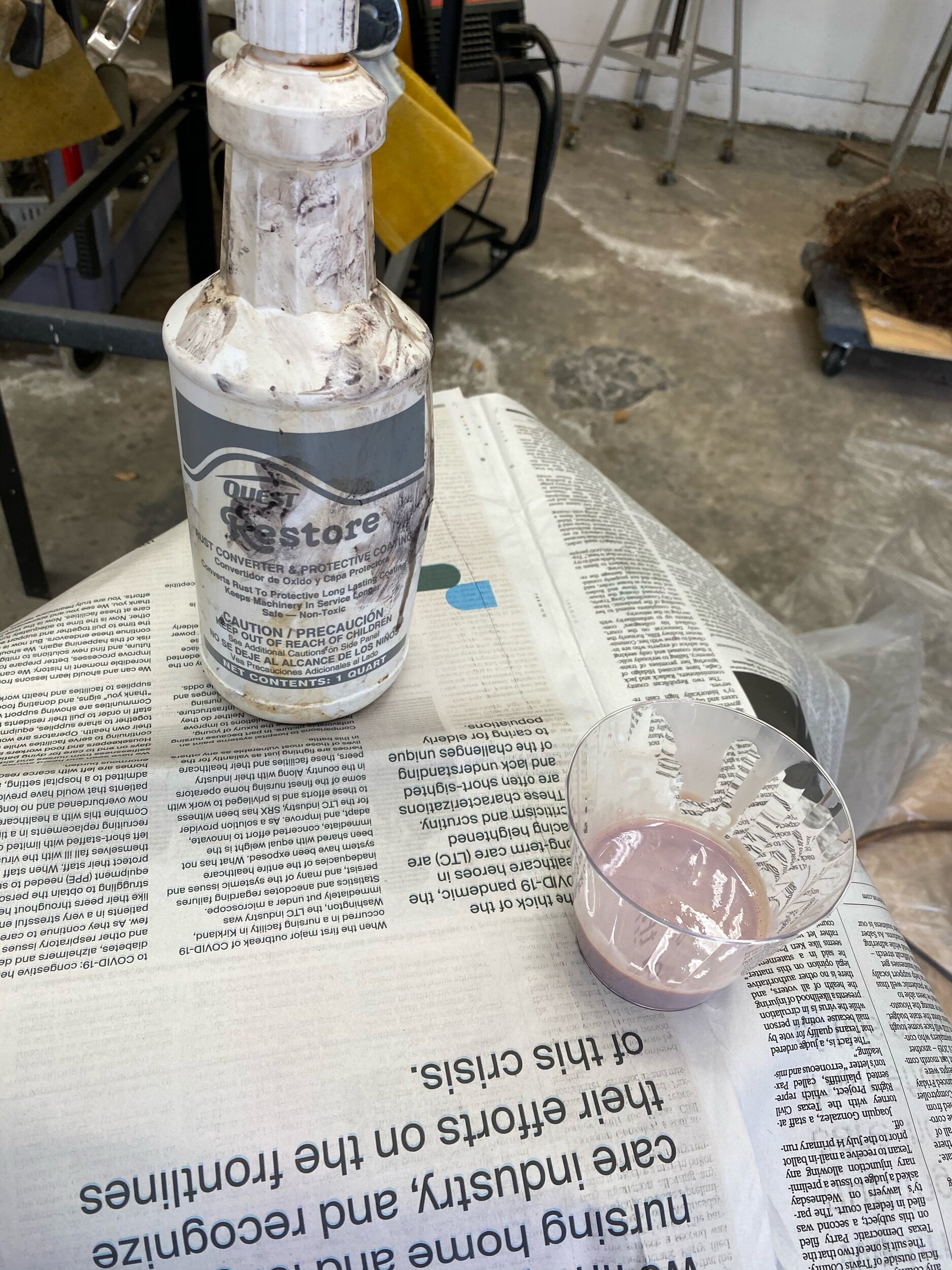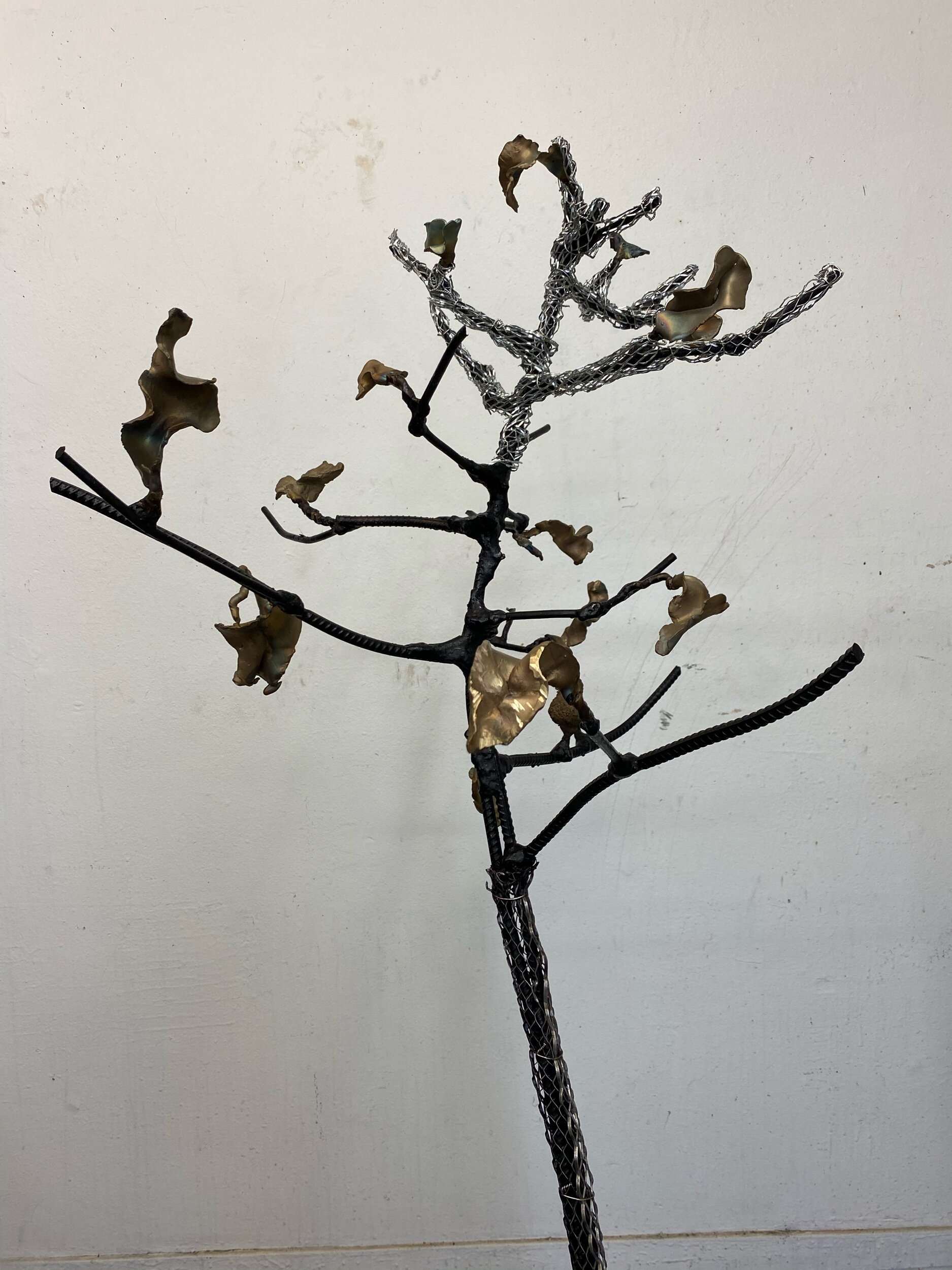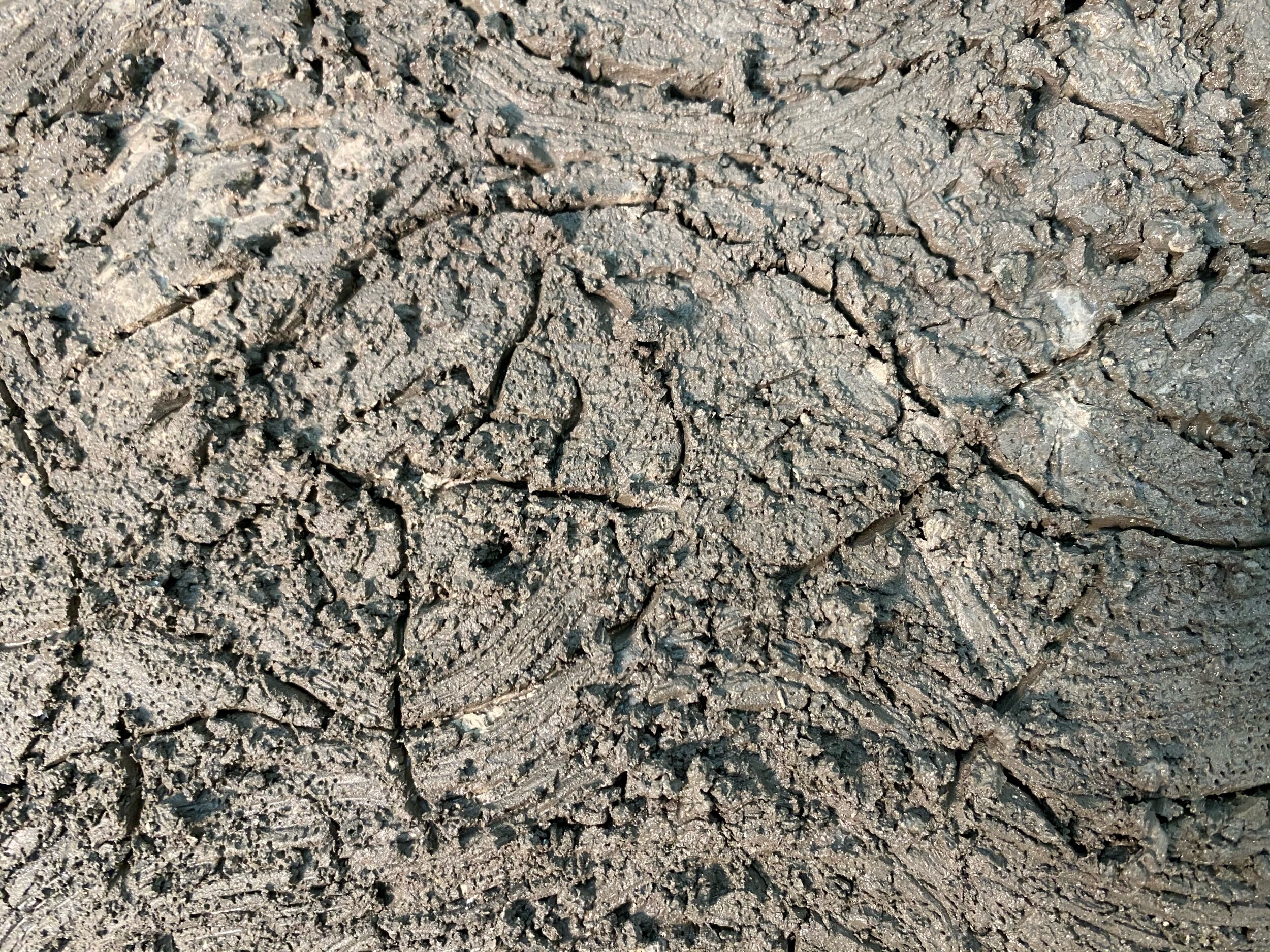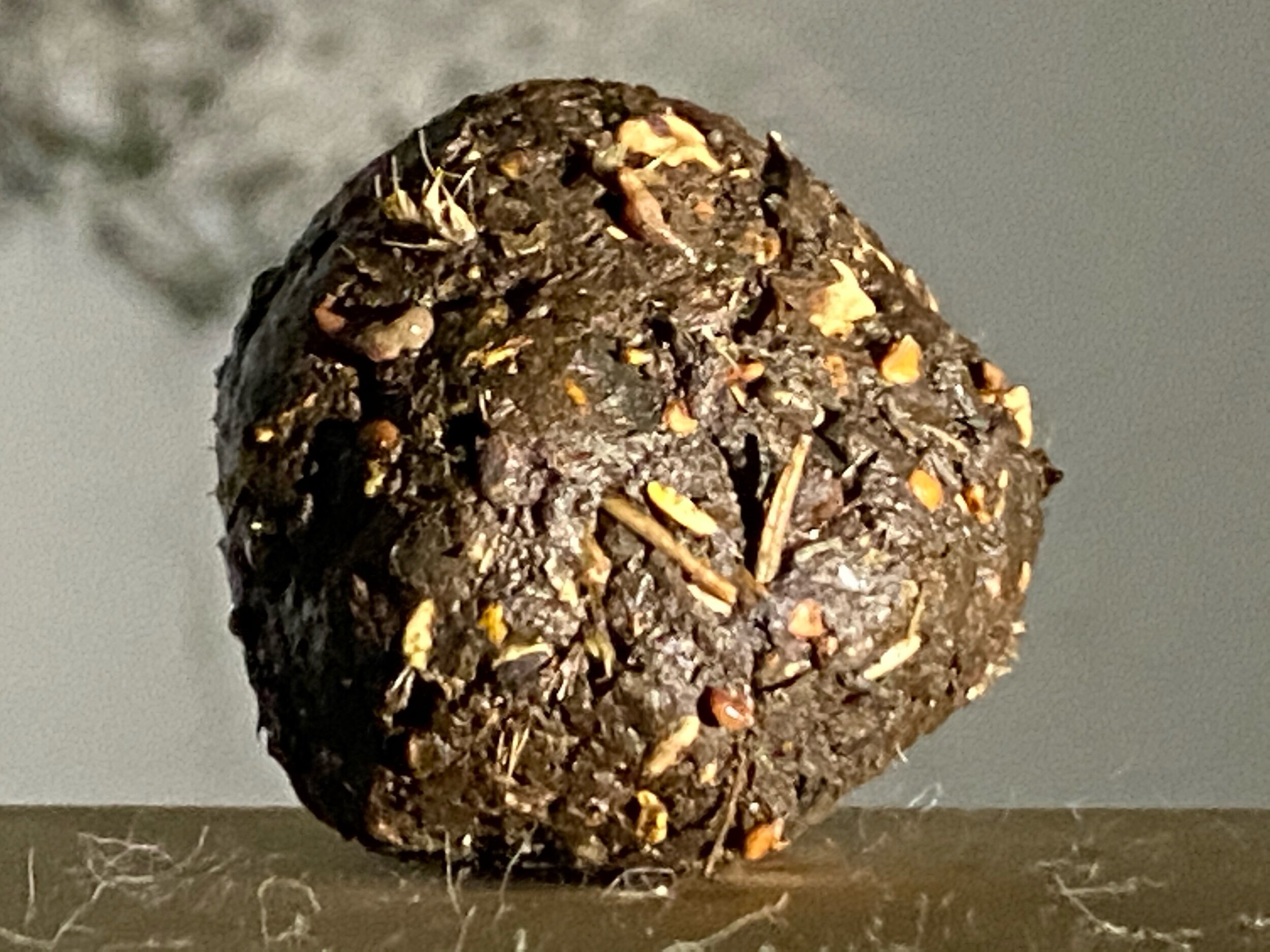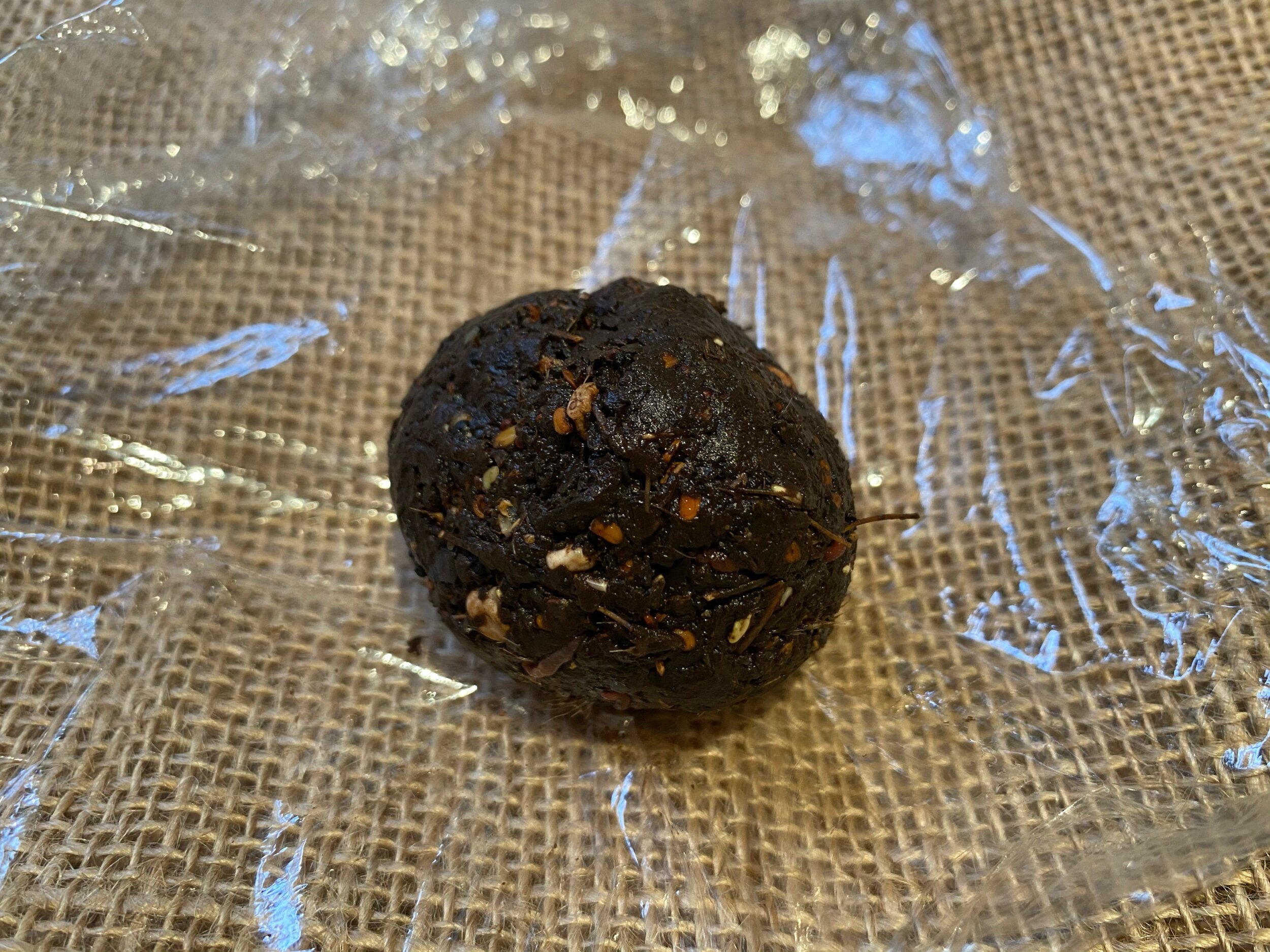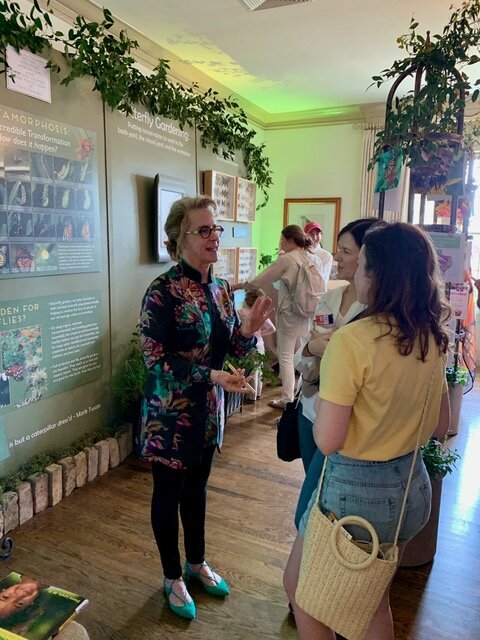It needs a light sanding, a patina on the bronze and the concrete.
Art Activist and City council woman #2
This was awesome to receive, I am feeling hopeful. It is amazing to have a city Council Woman who cares and listens to citizens opinions. Screenshot from my phone email.
Sally and Hannah
The video of the FY21 budget workshop-Parks and Recreation was very informative.
Here is what I got out of the video that will help you move the city in an environmentally forward direction. I have broken it down into five steps.
Steve Wright knows the value of native plants and grasses. He expressed that he would like to move more in that direction. He does not because the public is not educated. With Steve on board, this is a great opportunity, and the timing is perfect. Sally, it is great you identified this opportunity, by leading Steve you can save the city money and the planet.
Step One – In Steve's presentation, #5 Greenspace Management (GSM), the city is spending $2,000,000 on mowing esplanades, and in #15 Quality Assurance, they spend $2,500,000 for safety training to maintain the esplanades. Making all esplanades native grasses is a change that will free up a significant amount of money and help all insects as well as the bee. With Covid 19 sucking the life out of the country, the financial savings alone is reason enough to make the transition. This change will start the education of the citizens. Now is the time to take the first step in making Houston a leading city in environmental policy and help with the budget.
Step Two – Steve did not mention the chemical additives or equipment the city uses. City Parks and Recreation would also save money on the chemicals used on manicured landscapes such as herbicides, pesticides, fungicides, and neonicotinoids. This change would also impact the dollars spent on equipment and fuel for lawnmowers. Have Steve add that number up for you.
Step Three- Have Steve's people look at every area they manage: the city libraries, trails, parks, sports fields, golf courses. The zoo should also be charged with evaluating its grounds. Have them identify pockets in these city public spaces where they can save money by transitioning to native plants. There is a lot of precedent in other cities for native plant golf courses. Golf courses use an extreme amount of labor and chemicals; this could be a significant number in the budget.
Step Four – Steve mentioned Public Works land. It was not clear whose budget it is in, but it should be maintained in an environmentally forward thinking manner.
Step Five – Steve was concerned about the public's knowledge of the benefits of native landscaping versus the mindless conformity of the manicured landscapes that we are used to seeing. This education is a project for his new social media employee. In addition, the Mayor should call a press conference and make a big deal of the City Councils' commitment to not only the health of it’s citizens but also the environment and not mindlessly conforming to unhealthy chemically dependent landscape practices and to saving Houstonians a lot of money. The Mayor can also go into the benefits of restoring native prairie vegetation as it decreases water runoff and flooding, increases soil absorption of water and slows floodwaters on land.
A press conference is excellent advertising. It can also be addressed on the citiy’s website.
If you need inspiration, look at the 5/2020 National Geographic, Where Have All the Insects Gone? Pp. 40-65. The article is a study from 1989 to 2016 of flying insects. The study reported a 70% decline. You will find quotes such as "ecological Armageddon", "we find ourselves in the middle of a nightmare", "According to the website Altmetric, which tracks how often publish research is mentioned online, the study was the sixth most discussed scientific paper in 2017."
Insects do the dirty work for us; they pollinate, disperse seeds, are food for freshwater fish, and about every land animal, from reptiles to birds. They decompose our waste; without insects dead, organic matter will pile up. N. G reported the work insects do is equivalent to $57 billion a year in the US.
After you tackle the City Parks, we can look at residential and commerci
Sapling #6 - restore and lath
The only good thing about quarantine is it provides time to finish projects. I need to get my welding area cleared of these faux bois pieces.
Today I am starting back on the faux bois sapling. It has bronze leaves and 1 bronze bird. It is a special request for my daughter Sage. I started it two years ago and had exhibitions that came up that interfered with my completion. Oops-
She is now engaged to be married during the pandemic June 12, 2020. This is little sapling will now for both Sage and Cameron.
I put protective coverings over the bronze pieces.
My assistant Tobi is ready to help.- sarcasm
Here I am painting restore on the steel. Restore prevents it from rusting.
When you pour it is pink, it turns purple on the steel.
purple and bubbles.
After the restore dried I started attaching the lath
The lath th is sharp like a razor blade.wearing protective arm wear, I cut strips of the lath and attach it to the steel with stainless steel wire with airplane safety pliers. The lath can not wiggle. The concrete liquifies with movement so the lath has to be tight and firm.
Art Activist and City Council Woman
It was never my intent to become an environmental activist – I am beginning to wonder if that is what I am. Since the below email I have had one meeting with Sally Alcorn and her assistant Hannah Cobb. They are on board with my thoughts and want to help. We decided the first step is to look at the citi’s present landscape ordinance, and then Coronavirus 19 hit Houston.
I guess even in a pandemic certain things have to continue, such as city budget planning. I received an Instagram message from Sally April 27th at about 11:00 pm regarding a video of the City Council meeting and the City Parks budget. I will make another blog post summing up the results of that meeting. Maybe this pandemic will open some doors that normally would not budge.
TO: Sally Alcorn salliealcorn@comcast.net
Dec 27, 2019, 10:14 AM
RE: Houston’s impact on bees.
Sally,
It was great to run into you at the mother-daughter Christmas party. I appreciate your interest in positioning Houston to become the leading city in the U.S., addressing the native bee environmental issue. You have a lot on your plate with your new elected position, so I thought I would recap a few of the important topics we discussed.
Scientists predict that without pollinators, human life can only continue for four years. In 2017, the U.S. Fish and Wildlife Service listed the Rusty Patch Bumble Bee on the endangered species list. The campaign to list a species as endangered is lengthy and complicated. With this system, it is difficult to gauge how many species are actually endangered.
Bees are responsible for pollinating 75% of the world's flowering plants; they are crucial for the production of most fruits, nuts, and berries – our agriculture depends on pollination by bees.
Rural areas are highly impacted by the unanticipated consequences of our industrial agriculture’s dependence on chemicals that weaken bee’s immune systems. Urban bee populations can be more diverse than in rural areas. Researchers are finding in cities such as Chicago, Berlin, Berkley, and Melbourne that have reimagined their parks, neighborhoods, city centers, vacant lots, street medians, and rooftops planted with native flowers, grasses, and fruit, and vegetables support healthy, vibrant wild native bee populations.
In the US, there are four thousand native bee species. They pollinate over three hundred times more effectively than honey bees. For example, A single female Leafcutter Bee visits 100,000 plus blossoms per day whereas a honey bee visits 50-1000.
Unlike the honey bee, Native bees do not swarm, are not aggressive. Native bees are perfect for urban population centers.
Houston covers 600 square miles of land and has one of the longest growing seasons in the U.S. As it continues to sprawl across Texas, its gardens must increasingly become a refuge for native plants and animals. With 2.3 million people living in the most vital economic, cultural center of the south, we can become the most critical urban native bee habitat in the United States.
I have spent the last year and a half studying the bee situation as it pertains to my art and my interest in regenerative agriculture. I am determined to take this knowledge and save the bee in urban settings.
With Houston's land size, population, and location in the Sunbelt like it or not-we are impacting the bee population.
I realize we will have to start with baby steps. Let's put our creative minds together, save the native bees, and build a better energy capital. This is a great opportunity for our new city council.
I am very flexible are weekdays or weekends better for you to get together?
Best,
Cindee
P.S.
If Cuba can create urban gardens to feed it’s poor can you imagine what we can do.
Faux bois Wedding gift ❤️❤️#15
Today I poured 30 lbs. of white concrete and 29.5 lbs. of grey Portland for the seat. In the mix was .5 lbs. of the ashes of Robert Ira Travis, my dad. He was born on December 10, 1927 he passed away March 24, 2018. When I measured out the ashes thIs small metal piece was in his ashes. I think it must have been part of one of his four hip replacements or two knee replacements. It was like finding the toy in a box of cracker jacks. I think Griffin and Alex will enjoy it embedded in their piece.
Bolt, name and ashes of R.I. Travis.
I used the white concrete to create motion in the old wood.
I went a little crazy
The seat has lots of rings from burls in the plank. Griffin and Alex love bugs and mushrooms (the fruit of fungi) both of which cause burls. The seat of their bench is riddled with big burls.
A sweet knot with some severe old wood cracks.
Once the piece hydrates for 5 days I will take a sander and smooth down the seat.
I gave the birds a knot to perch on.
Another view of Bob Pa’s moment in the bench.
Every few hours I check on the marks to make sure they have not filled in. There is a lot of concrete on the seat and the white concrete is taking a long time to set.
Stitching a Sweat bee and incorporating time and movement
Another day of social distancing and not being able to get in my studio. Today's stitching, I added the first of several sweat bees. In reality, they are only about 1/4 ” long. They have beautiful metallic greens and blues. I am working to show more time and movement in my stitching.
I added a tiny sweat bee - he is moving fast and as a result blurry
First I cut some thread of the colors I want the bee to be.
Next I wad them up into a cocoon.
Then I untangle them into the shape of the movement of a bee.
Then I stitch them into the shape of the movement.
Sweat bees
I have had several people text me or Dm me to tell me about the bees they have seen this spring. That they are looking for bees during their Coronavirus afternoon walks. Some have was even said they would have killed the bees, except they knew I would not have been happy and that they need to protect the bees. It is so lovely to hear about these sightings. Thank you for the feedback- the role of an environmental activist artist can be frustrating at times. This feedback is inspiring. I love this native bee. Did you know this minuscule creature buzzing your native plants is a bee? I think it is a sweat bee part of the Halictidae family. There are 4,000 native bees and hard to identify. The Halictidae is the second largest family of Apoidea bees. Halictid species occur all over the world and are usually dark-colored and often metallic in appearance. With a macro lens, their colors are amazing. Several species are all or partly green, and a few are red; a number of them have yellow markings, especially the males, which commonly possess yellow faces, a pattern widespread among the various families of bees. (Source: Wikipedia, Halictidae, CC BY-SA 3.0) They are tough to photograph as they are swift and only about 1/4” - such a beautiful creature. Aren’t they cool.
Zoomed in
This gives you an idea how tiny these are.
Gorilla Art - native Wild flower bomb
Earlier in the year I sent the below letter to my City council representative. She is very supportive and agreed to review the Cities landscape ordinance and bring it up to date to reflect our current environmental situation as it pertains to native bees. The bees that are endangered, the honey bee is not endangered. I anticipate that with the health scare our city is facing our bees have been put on the back burner. Since the bees can’t wait for the c virus to die down, I decided I need to act. . Below is my letter. If you agree with me we need to all become gorilla artist and install texas wildflower seeds in every vacant spot we can. See my below post for how to be a gorilla artist and save the Native bees. If you want something done do it yourself. I still have hopes our city will reimagine our urban landscape and save the bees. #bees #houston #cindeeklementart #gorillaart Scientists predict that without pollinators, human life can only continue for four years. In 2017, the U.S. Fish and Wildlife Service listed the Rusty Patch Bumble Bee on the endangered species list. The campaign to list a species as endangered is lengthy and complicated. With this system it is difficult to gauge how many species are actually endangered. Bees are responsible for pollinating 75% of the world's flowering plants; they are crucial for the production of most fruits, nuts, and berries – that our agriculture depends on pollination by bees. Rural areas are highly impacted by the unanticipated consequences of our industrial agriculture’s dependence on chemicals that weaken bee’s immune systems. Urban bee populations can be more diverse than in rural areas. Researchers are finding in cities such as Chicago, Berlin, Berkley, and Melbourne that have reimagined their parks, neighborhoods, city centers, vacant lots, street medians, and rooftops planted with native flowers, grasses, and fruit, and vegetables support healthy, vibrant wild native bee populations. There are four thousand native bee species. They pollinate over three hundred times more effectively than honey bees. For example, A single female Leafcutter Bee visits 100,000 plus blossoms per day whereas a honey
Mix native wild flower or grasses seeds with soil. I am using a handful of compost from my bin.
Wrap it up so you can carry it and not get your hand muddy.
Find a place to throw it that will not be mowed. I picked behind this chain link fence, in the parking lot of my art studio.
Here she lays.
A closer look at - native wild flower seed bomb.
Three weeks later.
There are so many weeds sprouting up it is hard to see my seed bomb. But I see it. It does not have any blooms yet but my fingers are closed it will.
Since we are in quarantine I decided at this time to not make a bunch of bombs to share with others. I would love to share but I am erroring in the side of caution. i put the rest of my wild flower seeds in my flower beds that I needed more plants.
Azalea Trail and wild native bees
This summer it came to my attention that the River oaks Garden Club was having a luncheon with a bee theme. I quickly reached out to their luncheon Chair and she connected me to their environmental chairman. They came to my studio and we talked about the 4,000 wild bees species and how most people only know about honey bees.
Long story short I was invited to talk about the bees at their annual Azalea trail fundraiser. They were Slammed with people. I spoke none stop on Sunday from 11-5.
In addition the environmental chairs decided to work the native bee (the endangered bees) story into their both at their garden show this spring. It is organizations and ladies like these that can save the wild bees.
Image courtesy of Janna Webber
Falling through the bee looking glass #1
In the past years, blogging about my art practice was something I did every day. It is how I document my work. Then I started focusing on bees. At first, it was bees and the weed killer Glyphosphate.
The above pieces we're done in response to learning that Glyphosphate does not kill bees but impacts their immune system. With compromised immune systems bees subcome to disease. Glyphosphate is also now well known for causing cancer. I then made a five flip lenticular from these three images.
Sewing bee #6
I give these hand stitched caps to people that help me make an impact and bring back the endangered wild bees.
Bombus Affinis, the Rusty Patch Bumble bee was listed as Endangered January 11, 2017.
A great resource for learning about native bees is below.
https://xerces.org/wp-content/uploads/2016/10/2017-009_B-affinis_IDGuide_web.pdf
SITE Gallery- Sculpture Month Houston - Installing the work - my pregame plan
With lots of time spent preparing to install my work, installing it went by quickly.
During the days prior to the installation, I imagined trying multiple compositions of the pre-assembled sections, spending lots of time looking at it, adjusting it, and tweaking it and then adding smaller elements to tie the work together... and repeating the same process over and over until I was satisfied it was finished. That was my pre-game mental plan.
Once the support structure was in place, secure, and painted, it was time to install the work. First, I hung the two pieces I knew would be part of this work. I then looked at the way the shadows were falling on the concave surface of the wall and hung the two end pieces. It was then late in the day, and I decided to call it a day and decide what the next step was with fresh eyes in the morning.
The next day I showed up early in the day ready to sit, look and make changes that would be best for the work on the concave wall of a silo. I was excited to see the curator, Volker Eisele, in the parking lot when I arrived. I invited him to come take a look at my progress.
Smiling he said, "You are done, it is finished." I was really happy that he was pleased, really happy. I was also surprised. Finishing this early was not my game plan. Yikes! It isn’t easy for me to mentally change my game plan. I think Volker could see this in my face, and as he walked away, he said, "You know my name is on this too, it is good." I completely understood and reminded myself how lucky I was that he liked it.
A good problem.🙂
ps. I now have the equivalent of another silo full of work in my studio………. bursting at the seems. Anyone need a keystone animal environmental installation?
SITE Gallery- Sculpture Month Houston - Installing the work
This summer, I made 7 sections of kinetic sculptures, approximately 6’-10’ long X 36” in diameter, anticipating that I would not use all of them. Now that I am in the space and see what the light does on the convex wall, I think I will use 4 of my favorite sections and add 4 extra lines dropped for smaller pieces that will help integrate the 4 sections into one piece.
Experimenting with the placement of the light.
Experimenting with the shadows with the light in a convex wall.
The walls are not "museum pristine", they show their age, I am not bothered, it is a grain silo and I ❤️ It.
My new best friend’s name is Scissor Lift- Another day setting up my silo to work.
I am so grateful to not have to deal with that 19’ tall scaffold. It was very difficult to maneuver in the space with the mouth of the funnel hanging in the center of the space. Aztec picked up the awkward scaffold today, and they delivered my new best friend, scissor lift. Getting the scissor lift in my silo was not a simple processes. Electrical conduit hangs below the door frames of the silos between my silo and the delivery door. As a result the delivery man had to drive the scissor lift through 8 other silos to get to mine. It fit in the door of my silo exactly with not a pinch to spare. The scissor lift rubbed the top of the opening.
My safety engineer and the most supportive husband anyone could ask for. He is affectionately known as Mr.Safety. 🤗
The view of my silo workspace from the scissor lift.
Detail of grid system.
Tomato cage sculpture material
I ran to Southland hardware to purchase more wire cloth for my installation and spied some tomato cages. Wondering if they could add to my palette of materials I took home a few to play with.
Tomato cages
Squish, squash, twist, turn, fold, pull, cut repeat
Throw on a rip of charged screen for garnish
Play some more.
I ran out of time today but I feel like it might have some potential.
Five eyes
Bees have five eyes. They have three small ocelli eyes on the top of their head, they are simple lenses that discern light intensity. They also have two very large compound eyes that contains about 6,900 facets on the sides of their head. I thought the below monoprint of Bombus Affinis (Rusty Patch) bumblebee did a good job of showing the facets.
Bombus Affinis II compound eye detail.
Bombus Affinis - looking back and comparing
I ran into the print making room to drop off some new paper. I took the opportunity to see how the last 6 compared to each other and how multiple bees might look together. I will do one more experiment and the plan the grouping.
I am really liking these 6 today. I don’t think they are your typical rendering of a bee. Any thoughts? I am glad I took the time to look at these as a group. They are inspiring me to make several different bees from different views in this same technique and showing them together. I am getting some interesting ideas of how to do it.
i will do one more experiment first.
Sewing 🐝 #4 experiment for possible community project.
Sewing 🐝 #4
This piece is a conversation starter. The bee on this cap is the Bombus Affinis or commonly known as the Rusty Patch bumble bee. This bee was listed on the endangered species list in 2017. It is the first U.S. bee to be listed.
Finished piece.
No planing just winging it. It explains why that antenna is so BIG
This fuzzy little body needs some wings.
Detail of wing and legs
I need to delete the giant antennae.
Copy added
Every bee needs some pollen in the air.
After I finished and stood back I was not pleased. It was too busy, too much. Today I took out Impact. It feels better, I will live with it and maybe take out Endangered and the pollen and plant pieces.
Is destitching a word?
Nine things that can help #savethebees
1. Plant a pollinator garden
2. Pull weeds or better yet go native, as many weeds and wild flowers are food for bees.
3. Do not use herbicides to kill weeds. Bees live in the ground and neonicotinoids kill microflora in bee guts, making them less tolerant to bee disease.
4. Find natural ways to combat mosquitos. Many urban beekeepers tell me their hives suffer when city mosquito trucks spray and when their neighbors install mosquito misting systems.
5. Become an urban beekeeper.
6. Buy local honey that is not mixed with corn syrup.
7. Provide a water source.
8. Buy local organic food.
9. Spread the word.
Sewing 🐝 #4 experiment for possible community project.
Sewing 🐝 #4
This piece is a conversation starter. The bee on this cap is the Bombus Affinis or commonly known as the Rusty Patch bumble bee. This bee was listed on the endangered species list in 2017. It is the first U.S. bee to be listed.
Finished piece.
No planing just winging it. It explains why that antenna is so BIG
This fuzzy little body needs some wings.
Detail of wing and legs
I need to delete the giant antennae.
Copy added
Every bee needs some pollen in the air.
After I finished and stood back I was not pleased. It was too busy, too much. Today I took out Impact. It feels better, I will live with it and maybe take out Endangered and the pollen and plant pieces.
Is destitching a word?
Nine things that can help #savethebees
1. Plant a pollinator garden
2. Pull weeds or better yet go native, as many weeds and wild flowers are food for bees.
3. Do not use herbicides to kill weeds. Bees live in the ground and neonicotinoids kill microflora in bee guts, making them less tolerant to bee disease.
4. Find natural ways to combat mosquitos. Many urban beekeepers tell me their hives suffer when city mosquito trucks spray and when their neighbors install mosquito misting systems.
5. Become an urban beekeeper.
6. Buy local honey that is not mixed with corn syrup.
7. Provide a water source.
8. Buy local organic food.
9. Spread the word.

